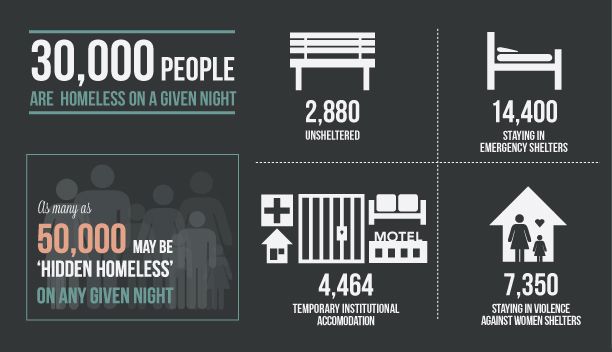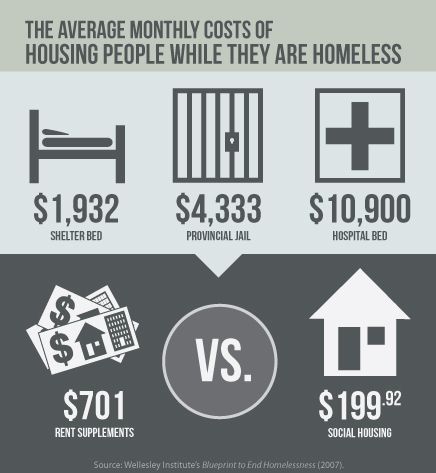Sometimes they DO listen. The Province of Alberta is miles ahead of every other government in Canada in terms of showing strong leadership and commitment to end homelessness. In 2009, they became the very first province/territory in the country to actually pledge to end homelessness. For three years their work was overseen by the Alberta Secretariat for Action on Homelessness which released a 3 year progress report card in 2012 on the goal of ending homelessness. In early 2013, the Secretariat was replaced by the Alberta Interagency Council on Homelessness. This council brings together several different arms of government, as well as other stakeholders, to ensure that there is a systems-wide response and commitment to the plan. There are seven cities in the province — Calgary, Edmonton, Lethbridge, Medicine Hat, Wood Buffalo, Red Deer and Grand Prairie — who have developed multi-year plans to end homelessness. Alberta also has a strategy to reduce child poverty.
The NIMBY syndrome — Not In My Backyard — is a huge problem in getting governments onside. Many politicians tend to listen to those people who a) have power and b) have money. As a result, home owners and neighbourhood associations often hold more sway than tenant groups and homeless advocates. Affordability and Choice Today has a great powerpoint presentation “Housing in My Backyard: A Municipal Guide for Responding to NIMBY.” While it’s geared towards politicians and municipal staff and politicians it can help anyone learn about overcoming NIMBYism. In a research report, “The Homeless Crisis in Canada: If Not in My Backyard, Then Whose? Overcoming Community Opposition to Homelessness Sheltering Projects Through the Use of Conflict Theory” Jeannine E. Wynne-Edwards looks at a variety of case studies to understand the roots of NIMBY opposition and suggests recommendations for countering it. Even governmental agencies have developed anti-NIMBY work. “Gaining Community Acceptance of Affordable Housing Projects and Homeless Shelters” is a report on workshops developed through a partnership between the Canada Mortgage and Housing Corporation and and the Housing and Homelessness Branch of Human Resources and Social Development Canada (HRSDC) to work with communities in addressing NIMBYism.
Political advocacy is multi-layered process. You have to make the right case, to the right people, at the right time. Using a variety of different techniques and tools often has the greatest impact. It isn’t an easy battle but it is winnable. It is possible to end, or at least extremely reduce, homelessness in Canada.
- Telling personal stories can have a huge impact. The Dream Team, a group of mental health survivors who advocate for supportive housing, have used videos, post card campaigns and lawsuits to challenge both NIMBYism and to call for more supportive housing. By telling their stories — see Philip and Linda sharing their stories — they help educate the public and government alike about the importance of supportive housing and how it helped get them off the streets.
- Write, email or call your politician. Since so many people don’t speak up your voice has power. You can find contact info for MPs here. Don’t forget, no postage is required to send a letter to your federal Member of Parliament. Ask them where they stand on the issue and what they plan to do to end homelessness.
- Build an alliance of like-minded people to share a similar message. Many cities — like Greater Victoria and Ottawa — already have coalitions to end homelessness or similar groups that are active and engaged. Join their mailing lists or volunteer with one of these groups to learn more.
- Stay informed so that you can speak about the issue using facts and figures. Both the Homeless Hub and the Canadian Alliance to End Homelessness have newsletters that provide great information and resources. Share these with your colleagues, friends and family.
- Use social media to your advantage. State the facts. Clearly. Repeatedly. Politicians can get overwhelmed with the barrage of information that comes at them daily. Here at the Homeless Hub we love sharing infographics and simple facts on Facebook and Twitter to make our points. In talking to politicians here are some resources and statements you can use:
In talking to politicians here are some resources and statements you can use:
a. Homelessness costs $7 billion annually.

b. More than 30,000 people are homeless any given night. (Pick a city near to your politician’s hometown that is close to that size and say “Imagine if everyone in XX city was homeless.” (As an example, Stratford, ON; West Kelowna, BC and Moose Jaw, SK are all very close to the 30,000 mark).

c. It is much cheaper to house people than it is to keep them in shelters, hospitals or jail.

AUTHOR: Gulliver, Tanya (2014) Homeless Hub.
